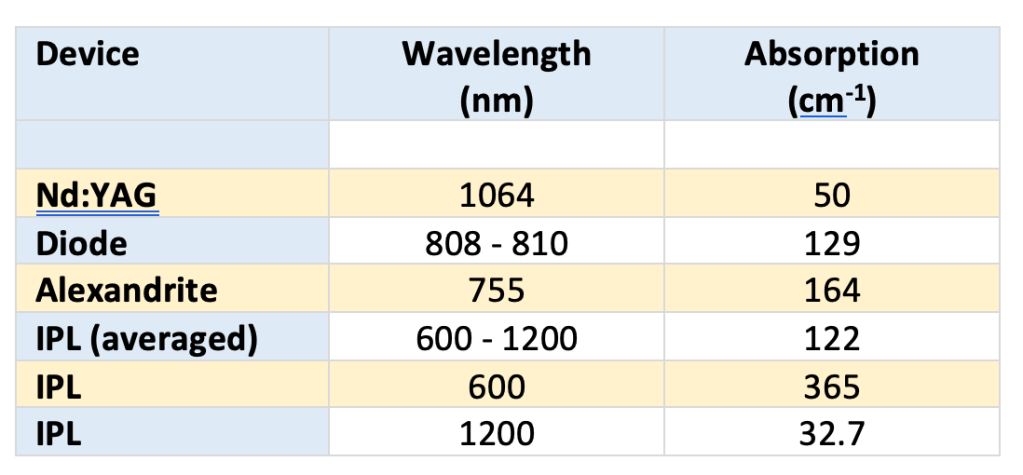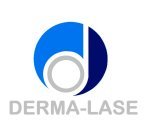Hair removal using light is currently the most popular aesthetic treatment on the planet today, apparently. These days we use diode, alexandrite and Nd:YAG lasers and IPL systems. But there appears to be some confusion over these different devices, with all sorts of dubious claims.
Let’s go back to first principles…
How does this treatment work? It’s quite simple actually – light energy is fired into the skin. Some of it is absorbed by melanin inside the hair shaft. This light energy converts into heat energy and the rise in temperature kills the follicle (if done correctly).
So what is the difference between the various lasers and IPLs?
Well, not that much! They all generate light energy – so that’s a good start. But they’re all different wavelengths. The importance of that is that the melanin absorbs different wavelengths to different extents.

The above graph shows that melanin absorbs light at the blue end of the spectrum very strongly, whilst it absorbs red light quite poorly (relatively speaking). So why do we only use red light for hair removal if it’s so poorly absorbed?
Well, it’s because red light can penetrate much deeper into the skin compared with blue or green or yellow light. The more red light we fire at the skin, the deeper its effectiveness is. Hence, we need to use higher intensities to reach deeper parts of the follicles.
Ok, so what sort of variation is there between the different systems?
Wavelength
Let’s look at the lasers first. They have the following wavelengths
Alexandrite – 755nm
Diode – 808 or 810nm
Nd:YAG – 1064nm.
These are all in the infra-red part of the spectrum – they are invisible to the naked eye.
From the melanin absorption graph above, we can see that melanin absorbs the alexandrite wavelength more than the diode or Nd:YAG wavelengths – in fact, the alexandrite wavelength is absorbed more than 3 times more readily than the YAG 1064nm wavelength (see ‘Absorption’ figure in the table below).
What this means is that, if we were to fire, say, 10 Joules of each wavelength at the same hair, more of the alexandrite light will be absorbed than the diode or YAG wavelengths. Likewise, more diode energy will be absorbed compared with the YAG, since it is better absorbed by melanin.
If we wanted to achieve the same amount of energy absorbed in the hair, we would need to compensate for the lower absorption by the diode and YAG wavelengths, by increasing their energies.
Hence, 30 Joules of the YAG energy would be equivalent to 11.5 Joules of the diode and 9 Joules of the alexandrite energy (assuming all else is the same).
IPL is different – it emits energy over a wide range of wavelengths (lasers can’t do that!). We use filters in IPLs to block the wavelengths we don’t want – the blues and greens and yellows. So a 640nm filter will only allow through the wavelengths above 640nm (up to 1200 nm, in many systems). Incidentally, when the power spectrum is averaged across the 600 – 1200nm output, IPLs output an ‘equivalent’ wavelength of 820nm! This is useful for comparative calculations…
From the graph above we can see that these wavelengths are also absorbed by melanin. If we set the output energy of an IPL correctly, we will achieve precisely the same conditions as we did above with the lasers.
Given that we’re simply trying to heat up the follicles, the total amount of energy we deliver to them will determine how hot they become. If we deliver the appropriate energy in each device, over the same time, then they will all generate the same temperature in the follicles.
Pulsewidth
But it’s not that simple! It never is…
For the systems above to generate the same temperatures in the hair, they would all have to deliver their energy in the same time – the pulsewidth (or pulse length or pulse duration).
And this is where the confusion appears to set in. If we fire some energy at some hair in a particular pulsewidth, then the temperature will rise to some level. If we fire the same energy at the same hair in half that time, then the maximum temperature – in the hair – will he higher.
Why? Because of heat conduction during the pulse. These pulsewidths are typically in the millisecond range. These times are sufficiently long for a significant amount of heat to ‘escape’ from the target, while the pulse is still active. In other words, some of the heat is lost into the surrounding tissues which means that the hair cannot become as hot (while the adjacent tissues become hotter too!)
So a 10J pulse of energy from an alexandrite laser in a 5 ms pulse, will not generate the same temperature as a 30J pulse from a YAG laser in a 20ms pulse – simply because the yag pulsewidth will mean that more heat escapes while the pulse is firing. The hair treated by the alexandrite system will be hotter.
And this is why this topic is so tricky.
Different systems deliver their energies in vastly different pulsewidths. Diode lasers can easily use pulses more than 100ms long to deliver higher energies. IPLs systems typically use up to 50 or perhaps 100ms to deliver their energy. Alexandrite and YAG laser are usually shorter than both diodes and IPLs.
Another consideration is that the temperature of the hair is not the critical issue. We’re trying to denature (cook) the germ cells during the anagen phase. This requires that their temperature is raised for a certain length of time.
The temperature and time are dependently linked – we can cook the germ cells at a lower temperature for a longer time, or at a higher temperature for a shorter time – it really doesn’t matter which!
How hot the hair becomes is actually quite trivial! The most important factor is how much energy is delivered into the follicle – THAT is what determines the final outcome! (I’m going to write a post about this topic soon…)
How do the technologies compare?
If used correctly, they are pretty much the same (apart from the quality!)
Let’s say you want to go to the local supermarket one Sunday morning. You might decide to drive there, or walk, or ride a bike or hire a helicopter! They all give you the same result – they just take different times.
Lasers and IPLs are the same – they can all generate the same results, but only if used correctly.
There are two main differecnes:
The first is that each system will interact with the epidermal melamin to a different extent. Alexandrite lasers will likely induce more epidermal damage compared with the other systems, purely because of its higher aborption. So these systenms tend to be used only on the lighter sin tones, while Nd:YAG laser are ‘best’ for darker skins.
The second main difference is versatility. Most of the skin procedures we apply today are based on preferential absorption of the light energy. To achieve this we must target certain chromophores in the skin – melanin, heamoglobin, water etc. The absorption coefficients of these chromophores dictate which wavelengths we must use, to maximise the amount of energy absorbed.
IPLs offer a wide range of wavelengths, usually from around 400nm up to 1200nm. Using filters, we can choose which range of wavelengths to apply. This, therefore, means that an IPL can target all of the above chromophores and treat a wide range of skin conditions.
The lasers above are much more limited since they only generate one wavelength each.
Incidentally, I often see a lot of nonsense about lasers being more ‘direct’ or ‘penetrate deeper’ or ‘more efficient’. These are all nonsense claims, usually from laser salesmen trying to push a sale!
The reality is that IPLs are more difficult to learn to use properly. This has resulted in them having a bad reputation, but that’s mostly because their users don’t know how to get the best out of them.
Conclusion
Laser/IPL hair removal is ‘tricky’. Understanding the processes is also tricky. It has taken me nearly 30 years to figure it out!! And I still haven’t…
But I do know that simple physics dictates that it’s all about the energy – not the wavelength, not the pulsewidth and certainly not the technology.
If you use your technology properly, you will obtain good results. I know this from experience. I also know that many people are not properly trained to use their own devices properly!!
That is the real confusion…
Hope this helps,
Mike.

PS Don’t forget about our next MasterClass in Luton near London, in September.




